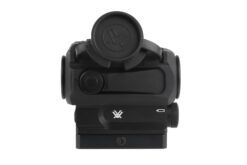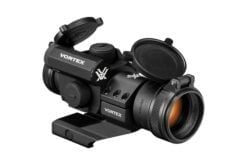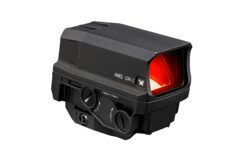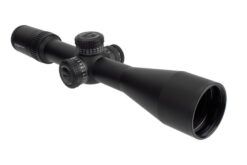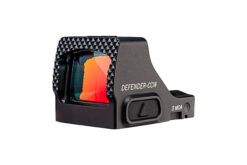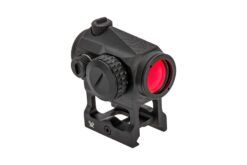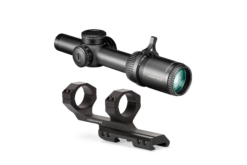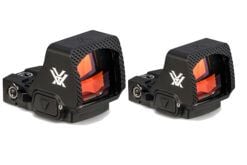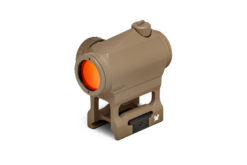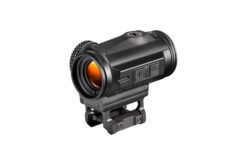Optics
Common Questions about Vortex Optics & Products
Table of contents
Regarding trusted optics in the shooting and hunting world, Vortex Optics has carved out a dominant position. Whether you’re a weekend plinker, an avid hunter, or a tactical professional, the Vortex line offers quality and affordability across various products. Known for rugged durability, precision engineering, and unmatched customer support, Vortex consistently delivers performance under demanding conditions. In this guide, we’ll answer some of the most common questions shooters ask about Vortex, covering everything from warranties to the differences between their popular scopes.
If you’re shopping for Vortex scopes, binoculars, red dots, or accessories, visit the Vortex Optics brand page at AR15Discounts.com for a wide selection at competitive prices.
Why Vortex Optics Stands Out
Vortex Optics‘ unwavering commitment to value, innovation, and customer satisfaction sets it apart. The company has developed a strong reputation for offering durable, high-performance optics at reasonable prices. From beginner-friendly options like the Vortex Crossfire II to more advanced models like the Vortex Viper or Vortex Razor, there’s something in their lineup for every type of shooter. Vortex invests heavily in research and development, continually updating its product lineup with cutting-edge technology. Additionally, their optics are rigorously tested under harsh conditions, ensuring reliability and accuracy whether at the shooting range, deep in the woods, or on tactical operations.
One of their most potent differentiators is the Vortex VIP Warranty—a valid lifetime, no-questions-asked replacement policy that covers accidental damage, even if you’re not the original owner. Combine that with crisp glass clarity, rugged construction, and intelligent reticle designs, and it’s easy to see why Vortex has become a household name in the firearm optics world.
Vortex Optics Product Line Breakdown
Crossfire vs. Diamondback vs. Viper – What’s the Difference?
- Vortex Crossfire II: Designed for budget-conscious shooters, the Crossfire II series is ideal for beginners and casual hunters. It’s known for its solid performance and essential features like capped turrets and a simple reticle. Despite its affordable price, the Crossfire II still delivers dependable durability, user-friendly adjustments, and respectable optical clarity, making it highly popular among first-time scope buyers.
- Vortex Diamondback: This is a step in glass clarity and build quality. The Diamondback Tactical version also offers exposed turrets and first focal plane reticles—excellent for precision shooting at mid-range. Shooters appreciate its improved low-light visibility, precision-focused adjustments, and overall versatility, bridging the gap between entry-level affordability and professional-level performance.
- Vortex Viper: Moving into the advanced tier, Viper scopes feature premium coatings, superior glass, and advanced reticles. These are a favorite among serious hunters and long-range shooters alike.
Vortex Optics Manufacturing & Quality
Where are Vortex Optics manufactured? Vortex designs many products in the USA, but manufacturing is spread across various countries. Entry-level optics like the Crossfire series are typically made in China, mid-tier optics in the Philippines, and higher-end models like the Vortex Razor HD are manufactured in Japan. The company’s headquarters in Wisconsin handles product development, rigorous testing, and customer support, ensuring that every optic meets stringent quality benchmarks. Vortex maintains close relationships with international factories, frequently auditing production processes to guarantee consistent performance and reliability across their entire product range.
Rest assured, every Vortex product—regardless of origin—is inspected under rigorous quality control standards to ensure top-tier performance.
Red Dots & Tactical Use
The Vortex Venom, Vortex Defender-CCW, and Vortex Sparc AR are popular red dot options designed for tactical use. The Vortex Defender is especially notable for its compact profile and rugged design, making it ideal for concealed carry or home defense. Meanwhile, the Vortex Strikefire 2 offers a great blend of speed and durability for AR-platform rifles. Additionally, shooters frequently praise the intuitive brightness controls, crisp dot clarity, and quick target acquisition of these optics. Their versatility is demonstrated by broad compatibility with handguns, shotguns, and rifles, accommodating diverse shooting applications from tactical operations to recreational plinking.
These optics are all shockproof, allowing them to endure recoil from larger calibers and rough use. Battery life varies, but the Vortex Venom and Sparc AR can run from several hundred to tens of thousands of hours, depending on the brightness settings.
Binoculars, Spotting Scopes, and Rangefinders
The Vortex Venom, Vortex Defender-CCW, and Vortex Sparc AR are popular red dot options designed for tactical use. The Vortex Defender is especially notable for its compact profile and rugged design, making it ideal for concealed carry or home defense. Meanwhile, the Vortex Strikefire 2 offers a great blend of speed and durability for AR-platform rifles. Additionally, shooters frequently praise the intuitive brightness controls, crisp dot clarity, and quick target acquisition of these optics. Their versatility is demonstrated by broad compatibility with handguns, shotguns, and rifles, accommodating diverse shooting applications from tactical operations to recreational plinking. Built with aircraft-grade aluminum housings, these sights withstand harsh environments and feature coatings that protect against fog, water, and scratches.
These optics are all shockproof, allowing them to endure recoil from larger calibers and rough use. Battery life varies, but the Vortex Venom and Sparc AR can run from several hundred to tens of thousands of hours, depending on the brightness settings.
Choosing the Right Scope
Best Vortex Scope for Hunting
For general-purpose hunting, the Vortex Diamondback and Viper HS are excellent choices. If you’re venturing into long-range hunting, consider the Vortex Strike Eagle or Viper PST with extended magnification ranges and precise reticle systems.
Low Light Performance
The Vortex Diamondback series excels in low-light conditions thanks to its fully multi-coated lenses. These scopes offer enhanced visibility during dawn and dusk—prime hunting hours.
Long-Range and Precision Shooting
If your focus is extreme accuracy at long distances, the Vortex Strike Eagle, Viper PST Gen II, or Razor HD Gen III should be on your shortlist. These models feature first focal plane (FFP) reticles and tactical turrets designed for dialing in shots at distance.
Mounting and Sighting-In
Mounting your optic correctly is crucial. Use quality rings or mounts—like Vortex’s own line—to ensure proper eye relief and level reticle alignment. Once mounted, sight in your optic at your preferred zero distance (typically 50 or 100 yards for AR platforms). Fire 3-shot groups and adjust your windage and elevation accordingly. Always torque mount screws according to the manufacturer’s specifications to avoid damage or shifting under recoil. Properly mounted optics from Vortex Optics enhance shooting consistency, accuracy, and confidence, especially during high-stress shooting scenarios or challenging hunting conditions.
Reticles: MOA vs. MRAD
Minute of Angle (MOA) and Milliradian (MRAD) are two units of angular measurement used for adjusting scopes. MOA is often preferred by hunters and those more familiar with imperial units, while MRAD is more common in tactical and competitive shooting circles due to its metric-friendly nature. Both units allow precise adjustments for windage and elevation, but MRAD typically facilitates quicker calculations at varying distances. Most Vortex scopes offer both options, allowing shooters to choose based on personal preference or the shooting discipline in which they participate. This ensures maximum versatility across hunting, tactical, and long-range competitive shooting applications.
Frequently Asked Questions about Vortex Optics
Do you have questions about Vortex Optics and its products? This FAQ covers the most common inquiries, from choosing the proper scope and understanding product features to warranty details and mounting tips. Dive in to learn how Vortex Optics can enhance your shooting experience.
What makes Vortex Optics stand out from other optics brands?
Vortex Optics stands out due to its extensive product lineup that appeals to all shooters—from budget-conscious beginners to seasoned professionals. Known for their exceptional value, Vortex Optics offers robust construction, clear glass, and innovative features across its optics. The unbeatable Vortex VIP Warranty also ensures lifetime coverage without questions, reflecting its unwavering commitment to customer satisfaction.
What’s the difference between Vortex Crossfire, Diamondback, and Viper scopes?
Vortex Optics scopes are grouped into several tiers based on price and features. The Crossfire series offers affordable scopes ideal for beginners, providing essential features for entry-level shooters. Diamondback scopes offer better optical clarity and improved lens coatings suited for intermediate-level users. The Diamondback Tactical variant adds exposed turrets and first focal plane reticles for precision shooting. The Viper scopes represent Vortex Optics’ advanced tier, featuring premium glass and sophisticated reticle designs. They offer enhanced durability, which is ideal for serious hunters and long-range shooters seeking exceptional performance.
Does a lifetime warranty cover Vortex Optics?
Yes, all Vortex Optics products come with the legendary Vortex VIP Warranty—a lifetime, unconditional warranty that covers accidental damage, defects, and issues without requiring a receipt or proof of purchase, even if you’re not the original owner.
Where are Vortex Optics manufactured?
Vortex Optics products are designed and engineered in the United States, primarily at their headquarters in Wisconsin. However, production varies by model: entry-level Vortex Optics (such as Crossfire) are typically made in China; mid-tier models like the Diamondback series are produced in the Philippines; and high-end optics like the Razor HD line are manufactured in Japan to precise specifications and strict quality control standards.
Which Vortex scope is best for hunting?
Vortex Optics’ Diamondback and Viper HS scopes are particularly popular for hunting. The Diamondback series is versatile and budget-friendly, ideal for hunting applications. At the same time, the Vortex Viper HS provides advanced features, superior optics, and durable construction suited for severe or specialized hunting scenarios.
How do I choose the correct magnification on a Vortex rifle scope?
Selecting the correct magnification for your Vortex Optics scope depends on your intended shooting distance and purpose. For general hunting and close-to-mid-range shooting, scopes like 3-9x magnification are ideal. Vortex scopes offering higher magnifications, such as 4-16x or higher, ensure better accuracy and target visibility for longer-range engagements or precision shooting.
Is the Vortex Sparc AR suitable for tactical use or home defense?
Absolutely. The Vortex Sparc AR red dot sight is engineered explicitly for tactical and defensive applications. Its compact and rugged design ensures rapid target acquisition, superior durability, and reliable performance, making it an excellent choice for home defense, tactical training, and law enforcement.
Are Vortex binoculars waterproof and fog-proof?
Yes. Vortex Optics binoculars feature waterproof and fog-proof designs, typically sealed with O-rings and purged with nitrogen or argon gas. This process prevents internal fogging and moisture intrusion and guarantees reliable performance even in challenging weather conditions.
Can Vortex red dots handle heavy recoil from large-caliber firearms?
Absolutely. Vortex Optics’ red dots, such as the Venom, Strikefire 2, and Sparc AR, are engineered with robust construction capable of handling heavy recoil from large-caliber firearms like shotguns, .308 rifles, and even higher-powered calibers without losing zero or compromising durability.
How do I mount and sight-in my Vortex optic properly?
Mounting your Vortex Optics product correctly is crucial for accuracy. Use high-quality mounts or rings explicitly designed for your optic and firearm platform. Ensure proper leveling, torque the screws to manufacturer-recommended specifications, and follow a precise zeroing process at distances of 50–100 yards to achieve optimal accuracy.
What’s the battery life of Vortex red dot sights like the Sparc AR and Venom?
Battery life for Vortex Optics red dot sights varies depending on the model and brightness settings. Generally, models like the Vortex Sparc AR and Vortex Venom offer battery life ranging from approximately 150 hours at higher brightness levels to 30,000 hours at lower, more economical brightness settings, allowing shooters extended reliability in the field.
What’s the difference between MOA and MRAD reticles in Vortex scopes?
Vortex Optics scopes offer reticles calibrated in either MOA (Minute of Angle) or MRAD (Milliradian). MOA-based reticles feature inch-based adjustments, making them intuitive for shooters accustomed to standard measurements. MRAD reticles utilize metric-based measurements, which precision rifle competitors and tactical shooters prefer. Choose the system that is best aligned with your shooting experience or discipline.
Which Vortex optic is best suited for long-range shooting or precision rifle matches?
Vortex Optics offers several standout models for precision rifle competitions or serious long-range shooting. The Vortex Viper PST Gen II, Vortex Strike Eagle series, and the premium Razor HD Gen III are built explicitly with advanced optics, precise tracking turrets, and sophisticated reticles for maximum accuracy and repeatability in long-range scenarios.
Can Vortex scopes withstand harsh weather and rugged conditions in the field?
Yes. Vortex Optics scopes are thoroughly tested to ensure performance in harsh environments. Their optics are constructed to be waterproof, fog-proof, and shockproof, with rugged housings and reliable seals that withstand extreme temperature fluctuations, moisture exposure, and heavy recoil.
How does the glass clarity of Vortex scopes compare to other premium brands?
Vortex Optics scopes deliver exceptional glass clarity, especially in their mid-to-high-end product lines, such as the Viper and Razor series. Many shooters find that Vortex Optics matches or surpasses the optical quality of competing premium brands within similar price points, offering impressive brightness, resolution, and low-light performance.
What are the main differences between Vortex Diamondback and Diamondback Tactical scopes?
Vortex Diamondback scopes provide solid mid-tier performance suitable for hunting and general shooting. The Diamondback Tactical series upgrades this platform significantly, incorporating first focal plane (FFP) reticles, exposed tactical-style turrets for quick and precise adjustments, and enhanced build quality specifically designed for precision rifle applications.
Is the Vortex Diamondback series suitable for beginner or intermediate shooters?
Yes. The Vortex Diamondback series represents a perfect balance of affordability and performance. It is highly suitable for beginner or intermediate shooters who want enhanced optical clarity, reliable performance, and intuitive adjustments without exceeding their budget.
Can the Vortex Diamondback handle recoil from powerful hunting calibers?
Absolutely. Vortex Diamondback scopes are built ruggedly enough to reliably handle recoil from powerful calibers, including popular hunting rounds such as .308 Winchester, .30-06 Springfield, and magnum calibers while maintaining accuracy and structural integrity.
Does the Vortex Diamondback provide clear visibility in low-light conditions?
Yes, particularly models like the Vortex Diamondback HP and HD. These versions feature specialized multi-coatings on the lenses that significantly enhance low-light visibility, contrast, and brightness, improving target acquisition during dawn or dusk hunting scenarios.
What type of shooting or hunting is the Vortex Diamondback best suited for?
The Vortex Diamondback is highly versatile and suitable for deer hunting, general target shooting, varmint control, and even introductory long-range practice. Its affordability, quality optics, and durable construction make it adaptable across numerous shooting disciplines and environments.
Final Thoughts
Whether investing in your first optic or upgrading to a long-range rig, Vortex Optics has an option that meets your needs without breaking the bank. You’re covered for any scenario, from the reliable Crossfire series to the advanced Viper and Razor lines. Each model is carefully engineered for maximum clarity, precision adjustments, and dependable performance. With exceptional warranties and unmatched customer support, choosing Vortex means lasting value and satisfaction.
Explore the entire Vortex Optics collection on AR15Discounts.com and elevate your shooting game today.
Additional references: www.arbuildjunkie.com


